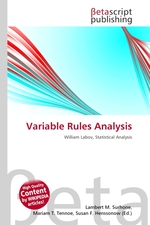Variable Rules Analysis
Lambert M. Surhone, Miriam T. Timpledon, Susan F. Marseken
бумажная книга
High Quality Content by WIKIPEDIA articles! In linguistics, variable rules analysis is a set of statistical analysis methods commonly used in sociolinguistics and historical linguistics to describe patterns of variation between alternative forms in language use. It is also sometimes known as Varbrul analysis, after the name of a software package dedicated to carrying out the relevant statistical computations (Varbrul, from "variable rule".) The method goes back to a theoretical approach developed by the sociolinguist William Labov in the late 1960s and early 1970s, and its mathematical implementation was developed by Henrietta Cedergren and David Sankoff in 1974. A variable rules analysis is designed to provide a quantitative model of a situation where speakers alternate between different forms that have the same meaning and stand in free variation, but in such a way that the probability of choice of either the one or the other form is conditioned by a variety of context factors or social characteristics. Such a situation, where variation is not entirely random but rule-governed, is also known as "structured variation".
Данное издание не является оригинальным. Книга печатается по технологии принт-он-деманд после получения заказа.


